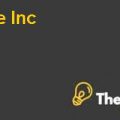
Loctite Corp.: Industrial Products Group
Introduction:
Loctite Corporation is a global leading manufacturing company of sealants, adhesives and relative products. The company was founded in the year 1956 and located in United States with its headquarter in Newington, Connecticut. The company performed extremely well in 1980s thus; it achieved tremendous growth in the adhesive market. As of now, the company is located in more than 33 countries other than United States. Majority source of the company’s sales is outside U.S.
Company Analysis
The objective of the company is to clear to every stakeholder who stated to become a leader of the adhesive industry. The company is a leader in the market of sealants and adhesive material. In order to achieve the consistency of being a market leader, Loctite Corp. focuses on the provision of high quality of products to its customers along with high price strategy in order to cover the cost. The structure of the company is divided into three profit centers with minimal internal rivalry.
The Industrial Products Group enjoys most of the company’s sales from the newer and advanced technologies that are CA and Anaerobic. These two products are free from any problems in comparison with the other technologies in the adhesive market. Moreover, the company has registered a patent against Anaerobic and enjoys 85% of the share in the market. The customers for Anaerobic are limited as they have not accepted the apparent advantages of the product.
On the contrary, the company is looking forward to take part in the estimation of market growth in the adhesive industry of the CA market. The company has successfully adjusted and differentiated the pricing of Cyanoacrylates products with the aid of market penetration to increase the volume of customers. The company is also using market skimming to attract and retain the loyal customers of Quickset404 who are not so price sensitive.
In addition to that, the company is differentiating itself from its competitors by manufacturing automatic adhesive dispensing equipment so as to harmonize the sales of Cyanoacrylates. Loctite Corp.’s system is engaged in the engineering and selling of automatic adhesive dispensing equipment for giant firms and is responsible for more than 15% of the sales.
Customer Analysis:
The Bond-A-Matic ought to be positioned not as an irrelevant product yet as a fitting item to Super Bond adhesives. Super Bonder adhesives will be utilized with Bond-A-Matic to stress linkage; this will be done when promoting the position of Bond-A-Matic as an extra tool for the Super Bonder glues, not the other way around. The center of the arrangement is to utilize the Bond-A-Matic as a technique for acquainting new clients with instant adhesives and to respond to the communicated enthusiasm of current CA clients with enhanced techniques used in dispensing.
The intended target groups for the plan range from small to fair-sized organizations that are non-clients and organizations that are CA clients, which will profit from utilizing the Bond-A-Matic; the commercial enterprises inside SIC 36 through 39. The businesses in this characterization extent are described by litter utilization; their items are liable to incessant changes in the design and henceforth are best suited for Bond-A-Matic that works with any Loctite Corp.’s adhesive. In addition, the Systems Division's tools indulge the need of bigger firms that can't be met by Bond-A-Matic. Hence, Loctite Corp. will be concentrating on its client by focusing their needs with the intention to expand the buy volume and keep away from the product offering cannibalization.
Further in light of the pricing strategy, which is discussed later on in the case; one can evade the design engineers and acquiring staff from getting included in the purchasing choice. Plant and production designers can settle on the buy choice about the dispensing equipment autonomously up to the expense of $250; which makes them their intended target group. This will aid in keeping up the contrasts in choice making techniques with different distributors.
Factors like unmistakable contrasts between Bond-A-Matic and different dispensers in value, adhesives to be utilized with and accuracy makes it appealing for diverse clients of Loctite Corp. that circles in with its strategic destination of increasing the base of new clients. More than 60% of firms utilizing more than three grams and not more than nine pounds of instant glues are the target clients of Bond-A-Matic.
Contender Analysis:
The Bond-A-Matic 2000 will be entering the business at a value point far below the programmed dispensers made by contenders that offer them for $483 and by IPG's System Division of $725 and $1200. As a manual dispenser, it will not be likely to take offer from contenders who make programmed dispensers cooked at bigger firms. Since current contenders have constrained assets and are highly divided in diverse territorial markets or particular businesses; hence there is minimal immediate danger postured by them. On the other hand, if offers of Bond-A-Matic 2000 build rapidly or the item is highly productive, then there are few hindrances to section disallowing new contenders from entering the business for mechanical adhesive dispensers. Moreover, an effective dispatch of BAM 2000 by Loctite Corp. may empower 3M, Eastman, and Permabond to start creating their dispensers for their line of adhesives also.
As a first-mover, Loctite Corp. has secured its preference in CA and has been developing among groups of industries by taking offer from contenders. While company’s advertising battle in FY 1978 unmistakably paid-off, still it must keep promoting to teach potential clients about its items and shift more clients to BAM 2000; consequently this will raise exchanging costs for contenders.
Product Strategy:
Gluematic Tip will be utilized as part of Bond-A-Matic for hard surfaces. Vari Drop needle in mix of Vari Drop instrument will be utilized for free falling drops and delicate surfaces. In this manner, to fulfill the recommended clients that are SICS 35-39, who are extremely heterogeneous concerning their commercial enterprises; the organization will give them both the heads. Loctite Corp. causes low cost for giving both heads.
Bond-A-Matic was produced as per the needs of assembly specialists and consequently imparts no interior competition to Gluematic Pen because of the diverse size. Bond-A-Matic not just inherits all the aces of Gluematic Pen but it also tackles the issue of obstructing and lumbering bottles of one oz jugs, refers from Exhibit 3 of the case. With the effective commencement of Bond-A-Matic, just 150 g containers will be utilized for clients requiring more than three grams of adhesive every year, hence declining the offers of one oz. So litter bottles among the 51% populace who communicated enthusiasm towards innovation related to dispensing. Thus Gluematic Pen will be reveled in by the family unit audiences with less than pound utilization. It is prescribed presenting Bond-A-Matic with its High Pressure model along with Low Pressure model. The proposed deals cost for Bond-A-Matic with both models is the same.
Low Pressure models are less expensive which brings about higher edges. In addition to that, Low Pressure models might be utilized with two separately four of five Super Bonder adhesives as well. Adhesives 495 and 425 must be utilized with Low Pressure model and contribute to half of existing sales. Adhesive 416 utilized for sporadic and permeable surfaces can be utilized with just a High Pressure model. Along these lines, the choices inside the item will be a flawless fit for unique target client’s needs......................
This is just a sample partial case solution. Please place the order on the website to order your own originally done case solution.
New product introduction strategy, covering all elements of the marketing mix must be scheduled on equipment for dispensing industrial adhesives. Equipment and adhesives produced by the same company. "Hide
by John A. Quelch Source: Harvard Business School 18 pages. Publication Date: December 1, 1980. Prod. #: 581066-PDF-ENG












